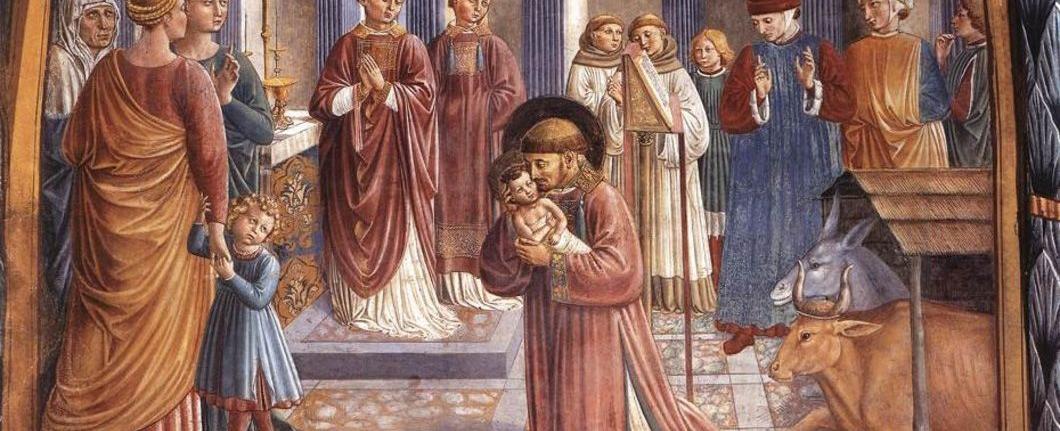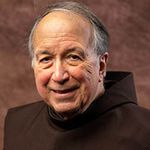Remembering Fr. Michael Blastic, OFM - Homily for 800th Anniversary of Christmas in Greccio

Peace and joy to all! This Christmas we continue to celebrate the 800th anniversary of the "living Nativity" that Francis and some of his brothers and lay friends arranged to celebrate in Greccio, Italy on Christmas Eve, 1223.
The Franciscan world was saddened during this joyous season by the sudden death on December 21 of one of the major scholars of our intellectual-spiritual tradition, Fr. Michael Blastic, OFM. Fr. Michael, a much-loved friar, was Distinguished Visiting Professor of Franciscan Studies at the Franciscan School of Theology in San Diego, California.

He composed this homily only several weeks ago; we are honored to publish it here as a tribute to his scholarship, and to continue his life's vocation of sharing the riches of our heritage with others.
May you be blessed with the riches that the poor Jesus brought us through his birth as one of us!!
Homily for 800th Anniversary of Greccio
Michael W. Blastic, OFM, Franciscan School of Theology. San Diego CA
November 16/18, 2023
I have a good friend in Chicago who worked for a not-for profit accounting firm that offered their services to the elderly and poor of the city. They would help them with health insurance, tax returns, and almost anything that had to do with finances. Over lunch one day he told me that I needed to meet a lady he had recently visited. She was somewhat eccentric and was living in an old three-story house without a lot of the comforts of modern living. She had a huge collection of cookie jars – thousands of them in all shapes and sizes. In what used to be the formal dining room, she had shelves of Franciscan cookie jars. The shape which you’ve probably seen or can imagine was of a friar with a tonsure, wearing a brown tunic with a cord with three knots and a hood, holding his very large belly with a huge smile on his face. It struck me as I walked around looking at them all, that I had never seen a cookie jar in the shape of a Jesuit or a Dominican? Have you? This woman certainly hadn’t either in all her years of collecting. What might this suggest? From one perspective, Franciscans were being caricatured as lovers of good food and big eaters, which is generally true. But on another level, what all those Franciscan cookie jars suggested to me was something more significant. Franciscans love life, in all of its highs and lows, and if we’re living Franciscan life well, we should be manifesting an appreciation for the goodness of the world and everything in it just as we find it. A cookie jar contains something good to be shared – a cookie to be savored and enjoyed, just like life itself. A cookie can sweeten life even amid troubles and woes. And somehow, the Friar-Cookie Jar is a sign of this.
Francis of Assisi loved Christmas, so much so that stories about him tell us that on Christmas day he wanted the walls to be smeared with meat, so that even the very physical structure in which we dwell can celebrate the feast of feasts. His companions tell us that Francis wanted to ask the emperor to pass a law that on Christmas day, people should throw grain on the roads to feed the birds, that domestic animals should be given extra portions of food, and that the poor should be fed until they are full. Responding to the brothers’ question of why such extravagance, Francis answered, “Because Jesus was born for us, we knew we would be saved!” Christmas, that is the celebration of God’s physical embodiment in our fragile frail flesh, is redemptive and we are saved by this, by God’s generous, extravagant, endless and abundant love!

That’s one of the reason Francis went to Greccio at Christmas time 1223 – to celebrate God’s extravagant love in Jesus’ birth and its effect on our world. And there, Francis did something that eventually gave rise to the tradition of the Christmas creche which continues to our day. But Francis’ creche that night was not accomplished with a representation of statues and miniature cribs and mangers as we have today, nor was it a “live” Nativity scene either. Francis represented the birth of Jesus in an open cave on a hill, with only a manger containing straw, and an ox and an ass nearby. No Mary and Joseph, no baby Jesus, no shepherds, or wise men. Just a cave open to the cold of a winter’s night, and a food trough for the ox and the ass. As Thomas of Celano tell us, Francis’ purpose in doing this was “to enact the memory of that babe who was born in Bethlehem: to see as much as is possible with [our] own bodily eyes the discomfort of his infant needs, how he lay in a manger, and how, with an ox and an ass standing by, he rested on hay” (1C 84). For Francis, God’s extravagant love took flesh in the inconvenience of this birth, a birth in a place that was not a comfortable home or hospital, without a crib and the warmth of a hearth, in a natural shelter for animals, in a place “along the way.” But this place of Christ’s birth in this out of the way place, in these uncomfortable surroundings became the center point of human history where God entered into our world in our flesh and blood: the extravagant love of God became available to us as a poor fragile baby boy. As Celano described the celebration he commented that, “The night [was] lit up like day, delighting both man and beast. The people arrive[d], ecstatic at this new mystery of new joy. The forest amplifie[d] the cries, and the boulders echo[ed] back the joyful crowd. The brothers s[a]ng, giving God due praise, and the whole night abound[ed] with jubilation.” The glorious Word of God has taken flesh in our world, and Celano concluded with the affirmation that, “There simplicity is given a place of honor, poverty is exalted, humility is commended, and out of Greccio is made a new Bethlehem.”
The earth, God’s good creation, and humans harmonized and rhapsodized together giving glory to God. Francis then preached a sermon at the Eucharist celebrated there in that cave. One can imagine too, that Francis, like all those present, in seeing the mystery of creation’s glorification with the birth of Jesus in that cold stark cave, was taken up with the joy of Christmas, and spoke about the great gift of peace that Christmas accomplished: “Glory to God in the highest, and on earth peace to people of good will.” The Eucharist, the Body and Blood of the Lord, re-presents the incarnation, when just as Christ humbled himself and took flesh in the womb of Mary so “each day he comes down from the bosom of the Father upon the altar in the hands of the priest.” The Eucharist makes present the incarnation of Jesus, and because he is born for us, we know we will be saved!
Thus, for Francis, the creche – in its stark simplicity and poverty – symbolizes how Greccio becomes a new Bethlehem. This means that the creches that we prepare in our homes for Christmas, should remind us that our homes, our world, is to be made into a new Bethlehem:
- a new Bethlehem as a place of joy because we know we are loved just as we are;
- a new Bethlehem as the place where lived simplicity, humility and patience embody God’s peace;
- a new Bethlehem as the place where humans together with creation, in harmony and in mutual respect and honor give glory to God;
- a new Bethlehem as the place where the poor are filled;
- a new Bethlehem as the place where God is made present in the mutual love and compassion we show to everyone;
- a new Bethlehem, as the place where Christ is at home in the love of men and women given without cost, without distinction, and without strings attached;
- a new Bethlehem where we accept each person for what they are, the beloved of God.
More than just a representation, Greccio became a place of spiritual and physical healing for both humans and animals who came in contact with that place and the straw that was placed in the manger that night. The incarnation is our salvation – God entered into our world to make us whole again, to facilitate reconciliation, healing, and human flourishing so that we might enjoy God’s peace and wellbeing as the fruit of his love for all that exists. The creche challenges us to live with the same extravagant compassion and care for one another and all as did Francis and Clare of Assisi, who followed the footprints of Jesus.
As we bless the creche here, and when you bless the creche in your own Greccio’s, let us ask God to help us make our homes into a new Bethlehem.

May the creche remind us that sharing God’s extravagant love with all our brothers and sisters and caring for creation, is the way to make our world into a new Bethlehem where God is with us.
May God’s extravagant, endless, and abundant love be born in us anew, and may it be the path of salvation for all of us.
May we give glory to God in the highest by sharing the peace of Christmas, and making our entire world into a new Bethlehem as now we bless the creche:
God of Mary and Joseph, of shepherds and animals, bless us whenever we gaze on this manger scene.
Through all the days of Christmas may these figures tell the story of how humans, angels, and animals found the Christ in this poor place. Fill our house with hospitality, joy, gentleness, and thanksgiving, and guide our steps in the way of peace.
We ask this through Christ, our Savior.
Amen.
Dominic Monti, OFM
Professor of Franciscan Research in the Franciscan Institute of St. Bonaventure University
Dominic V. Monti, OFM, is a Franciscan Friar of Holy Name Province (USA) and currently professor of Franciscan Research in the Franciscan Institute of St. Bonaventure University. He devoted the greater part of his ministry to teaching the History of Christianity, in particular the history of the Franciscan movement. He has contributed two volumes to the Works of St. Bonaventure series and is author of Francis & His Brothers, a popular history of the Friars Minor.

